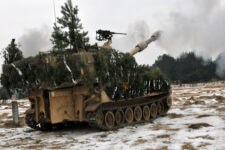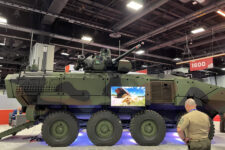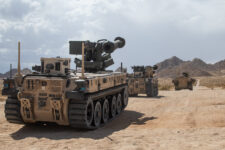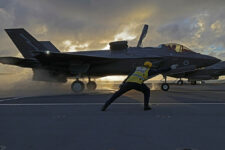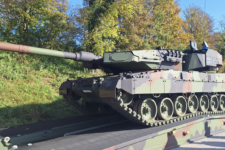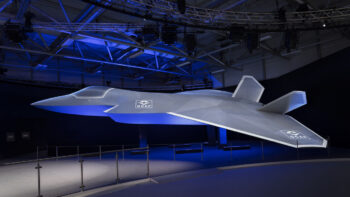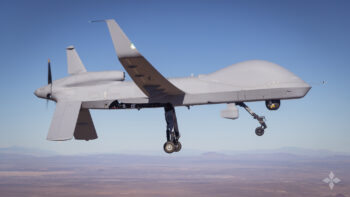
A U.S. Army Soldiers, assigned to 5th Battalion, 4th Air Defense Artillery Regiment, move out in their M-SHORAD during Exercise Saber Strike 22 at BPTA, Poland on February 24, 2022. (U.S. Army photo by Maj. Robert Fellingham)
Since Russia invaded Ukraine, Pentagon officials have argued that the incursion is the clearest sign yet that the robust budget for America’s military is more than justified. But in the op ed below, retired Army Lt. Col. Daniel L. Davis argues that Russia’s failures on the ground suggest quite the opposite, and that if anything, the budget should shrink along with America’s international military footprint.
National defense is enshrined in the US Constitution, with Congress being given the obligations of raising and sustaining the military, giving it oversight, and having sole power to declare war; the president is required to serve as commander-in-chief. But it is dangerously past time to recognize the Constitution obligates American defense, not the defense for any country on the planet that desires to use Americans for its own security.
The current path could very well destroy our country: We will either go bankrupt trying – or worse – will eventually get sucked into a major war that we should never have fought, suffering egregious and unnecessary military losses, and, in a worst-case scenario, suffer nuclear weapons being detonated over American cities. None of that needs to happen.
The current military budget being proposed by Congress is an astronomically high $813 billion. Defenders of this figure claim it is the minimum necessary and “critically important” to ensure our national defense. Such claims, however, don’t stand up to even minimal scrutiny. My own experience serving in the Army during the Cold War provides compelling proof of the problems with such claims.
In late 1989 as a green Army second lieutenant, I was assigned to the 2nd Armored Cavalry Regiment (2ACR) in Bamberg, Germany. The 2ACR was one of three armored cavalry regiments tasked with active patrolling of the Iron Curtain dividing the east from the west. We faced off against the frontline troops of the Soviet Union and Warsaw pact nations, totaling 22 countries, composed of a staggering figure of over 200,000 tanks, armored personnel carriers, and artillery cannons – manned by 3.5 million active troops [PDF].
Oh, and an incomprehensibly large number of nuclear weapons somewhere north of 35,000 warheads.
Against this adversarial behemoth the United States fielded an active duty force of 2.1 million troops. To fund America’s national defense, with this substantial forward-deployed force arrayed against this massive Soviet force, the US Congress approved a budget of $295 billion dollars. In today’s dollars, that would be approximately $674 billion.
Consider that stunning reality: in 1989 when the US was part of a NATO alliance comprising only half as many states as today’s NATO, funding over 2 million US troops, and facing a 22-nation adversarial alliance manned by 3.5 million troops – we funded the DoD to a level $139 billion less than the proposed FY2023 budget of $813 billion that will fund an active US force consisting of 700,000 fewer troops, in an alliance of 30 member nations, against a single country with 2 million fewer troops than the Warsaw Pact alliance and having just exposed its ground force as less competent than once assumed.
The big takeaway from a military perspective of Russia’s war against Ukraine is how stunningly limited Moscow’s ground forces have proven to be. In 2016 a RAND study suggested the Russian ground forces could overrun all three Baltic nations in as few as 36 hours. Now we know the Russians have proven incapable of capturing even half of one (larger) country after five full weeks of full-scale war. Even more critical: Russia has suffered extensive materiel losses, has been gouged of its most trained soldiers, and has expended significant portions of its precision-guided missile inventories.
By any objective measure, Russia’s conventional forces should now be seen as a mediocre regional force with very limited ability to project power more than a few hundred kilometers beyond its border. But because of the damage it continues to endure in Ukraine, it will be upwards of a decade before they even recover their pre-war limited capacity, much less become a threat to the NATO alliance.
Yet in the face of these blatantly obvious military realities, the senior commander of the US European Command wants more troops.
Gen. Tod Wolters told a Senate panel on Tuesday that his ”suspicion is we’re going to still need more” troops in Eastern Europe after the conclusion of the Russo-Ukrainian War. The number of US troops has jumped to over 100,000 from the already-high 60,000 just months ago. No one is addressing the elephant in the room: Why?
Why is it necessary for America’s defense to send a major surge of troops to permanently man NATO’s eastern flank – especially after Russia’s failure of strategy in Ukraine?
Why, in any case, should the United States, rather than other NATO members, send tens of thousands of troops to Eastern Europe?
Why is it necessary – or even desirable – for America to reassert itself as the defender of first choice to Europe rather than require rich European countries to be their own first line of defense with the US acting as the dependable back-stop?
These questions aren’t being asked by anyone in Washington, and they definitely aren’t being answered. Yet these should be the first questions considered because they are fundamental to our national and economic security.
Trying to continue filling that role will either bankrupt us – as these increasingly astronomical and perpetually rising defense budgets are threatening to do – or get us dragged into major wars that we should never have to fight.
We must acknowledge painfully evident reality, provide for our national defense to necessary levels and enable our armed forces to meet our global treaty obligations, but stop the unsustainable and irrational drive to always and forever be the military force of choice for large portions of the globe.
Daniel L. Davis is a senior fellow for Defense Priorities and a former Lt. Col. in the US Army who deployed into combat zones four times. He is the author of “The Eleventh Hour in 2020 America.” He is on Twitter @DanielLDavis1.
Army inks $435 million deal for new TNT production facility
“Reshoring TNT production gives us the ability to control and secure our supply chain for this vital component, especially in an era of increasing global challenges,” said Army acquisition head Doug Bush.
